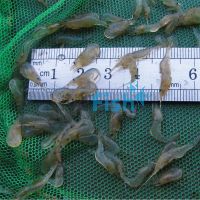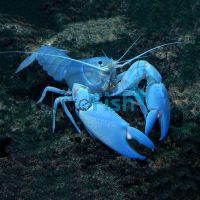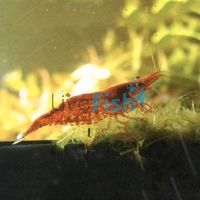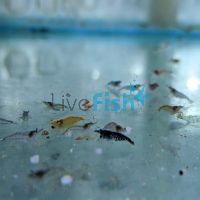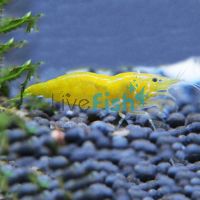Here we'll focus on cherry shrimp and yabbies (Australian freshwater crayfish), so be sure to check out the individual species pages for further information.
Shrimp and Crayfish Care
As mentioned, these invertebrates are super hardy and tolerant of varying water parameters. In fact, you would be hard-pressed to find a tropical aquarium setup that would not be suitable for these animals. By far the most popular shrimp pet in the aquarist hobby is the cherry shrimp, which grow to just 3.8 cm (1.5”) and can live up to 2 years. They come in a wide range of brilliant colours, with red being the most common and yellow being another massively popular choice. Yabbies can live for up to seven years and reach a whopping 30 cm (12”) in length, so be sure to prepare for this if you are interested in keeping them as pets.
Natural Habitat
Cherry shrimp are native to Taiwan, where they can be found in slow-moving streams and ponds. In the wild, they require rocky areas with plenty of hiding spaces. Yabbies are native to Australia, particularly Victoria and NSW. They are considered an invasive species in Western Australia, where they compete with native marron and gilgies. Although yabbies are considered a vulnerable species in many of its natural waterways such as the Yarra, they are commonly found thriving in various lakes, dams and billabongs.
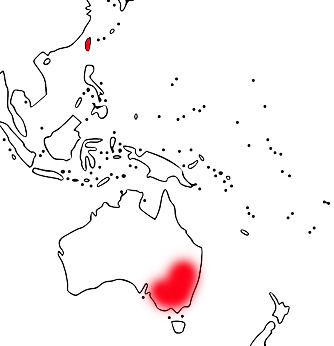
Behavior/Compatibility for Shrimp and Crayfish
Cherry shrimp are an incredibly placid species that will cause no problems with any other freshwater aquatic life. However, if you’ve ever enjoyed a prawn cocktail, you’ll understand how most fish feel about shrimp. As a general rule, never mix shrimp with any fish that has a mouth large enough to swallow one. Certainly avoid mixing with oscars, cichlids, arowana and the like, and expect to lose most of your juvenile shrimp if you plan on breeding them in a community tank. Some great tankmates include other cherry shrimp, Corydoras, dwarf gourami, tetras and small rasboras.
Yabbies have a bit of the opposite issue with tankmates. Highly territorial and capable of eating just about anything that won’t eat them, yabbies should ideally be kept alone. A very unpredictable animal, they may cohabit with no problems at all or they may destroy your community. However, they are a brilliant pet to keep just on their own, particularly the vibrant neon blue pearl variety.
Housing Shrimp and Crayfish and Tank Set-up Tips
Tank
Cherry shrimp require very little room and can be housed in tanks as small as 10 litres (2.5 gallons) for 10 cherry shrimp (the minimum recommended group size). To accommodate for the impressive maximum size that yabbies may reach, a minimum of 30 litres (8 gallons) is recommended. If you wish to house more than one yabbie you will need to double this size as they may be very aggressive with each other. If you ever add a new yabbie to a tank already housing one, carefully remove your existing yabbie and rearrange all rocks, plants and decorations to try to ‘reset’ territorial bounds. Ensure both yabbies are roughly equal in size, then introduce them to your tank at opposite ends.
Recommended Max Shrimp Tank Volume 10 Cherry Shrimp 10 litres (2.5 gallons) 20 Cherry Shrimp 20.8 litres (5.5 gallons) 30 Cherry Shrimp 30 litres (8 gallons) 40 Cherry Shrimp 37.8 litres (10 gallons) Recommended Max Crayfish/Yabby Count Tank Volume 1 Crayfish 30 litres (8 gallons) 2 Crayfish 52 litres (14 gallons) 3 Crayfish 77 litres (20 gallons) 4 Crayfish 94 litres (25 gallons) Base
Both shrimp and yabbies are scavengers, so sand or fine gravel substrates are best.
Foliage
Shrimp and yabbies will require adequate hiding places, so be sure to include decorations that include holes and caves with which they can make their home. Shrimp will appreciate large flat stones from which they can clean algae and well stock plant life. Java moss is perfect for cherry shrimp.
Water
These animals are incredibly tolerant of water conditions and can happily handle temperatures of anywhere between 20-29 degrees C (69-81 F).
Your Ph should be 6 - 8 and you should aim for a hardness of 5 - 15 DGH, though parameters beyond this should also be fine within reason. To ensure your pH and hardness are suitable you should invest in a water testing kit. Always ensure your water is properly filtered, and regularly change the water, though you should be fine with just a 10% weekly water change.
You should also filter the substrate regularly and adjust the chemistry of any tap water you use to top your tank. You may do this with one of our many water conditioning products.
One thing to note is that invertebrates are particularly susceptible to copper poisoning, so be sure to avoid any treatments that include copper.
Shrimp and Crayfish don't require a deep tank, so a longer shallower tank will be best for them if you aren't keeping them with other fish.
Feeding and Care
These animals are not picky eaters in the least and will happily accept just about anything offered. Yabbies enjoy beef mince, potato peels, peas and specially formulated yabby food. Shrimp will appreciate any sinking pellet food and blanched veggies like spinach or zucchini. As they are messy eaters you should be very careful not to feed these animals and remove any unfinished food.
Great reasons to keep Shrimp & Crayfish in your tropical fish tank
- As they are so low maintenance they make a great beginner fish pet, especially for children.
- Shrimp can liven up a community tank with some real variety beyond the typical fish.
- They are remarkably easy to breed for fun and occasionally profitable.
